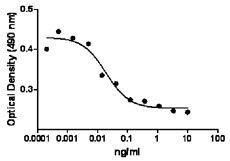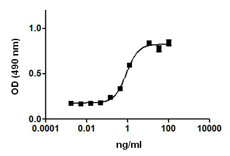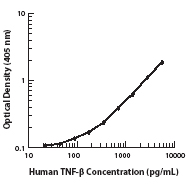- Regulatory Status
- RUO
- Other Names
- Lymphotoxin-alpha (LT-α), Tumor necrosis factor-β, TNFSF1
- Ave. Rating
- Submit a Review
- Product Citations
- publications
| Cat # | Size | Price | Quantity Check Availability | Save | ||
|---|---|---|---|---|---|---|
| 562603 | 5 µg | 118€ | ||||
| 562604 | 20 µg | 184€ | ||||
This product is not available for shipping outside of the United States.
LT-α, also known as TNF-β, is a potent mediator of inflammatory and immune responses. It belongs to the TNF superfamily of ligands and signals through TNFR1 and TNFR2. LT-α is produced by activated T and B lymphocytes, and has similar activities to TNF-α. Like TNF-α, LT-α (TNF-β) is involved in the regulation of various biological processes including cell proliferation, differentiation, apoptosis, lipid metabolism, coagulation, and neurotransmission. LT-α is secreted as a soluble polypeptide, but can form heterotrimers with LT-β, which effectively anchors the LT-α to the cell surface. LT-α is cytotoxic to a wide range of tumor cells. Recombinant human LT-α is secreted 171 amino acid protein (18.6 kD) which forms an active non-disulfide linked homotrimer structure in solution.
Product DetailsProduct Details
- Source
- E. coli, approximately 18.6 kD
- Formulation
- Sterile filtered through a 0.2 micron filter. Lyophilized from 0.3x PBS, pH 7.2.
- Endotoxin Level
- Less than 0.1 ng per µg of protein.
- Storage & Handling
- Unopened vial can be stored at -20°C or -70°C. For maximum results, quick spin vial prior to opening. Reconstitute in water to a concentration of 0.1-1.0 mg/ml. Do not vortex. It is recommended to further dilute in a buffer containing a carrier protein such as 0.1% BSA and store working aliquots at -20°C to -80°C. Avoid repeated freeze/thaw cycles.
- Activity
- The ED50 as determined by cytolysis of murine L929 cells in the presence of Actinomycin D is ≤0.05 ng/ml, corresponding to a specific activity of ≥ 2 x 107 units/mg.
- Application
-
ELISA, Bioassay
- Recommended Usage
-
Each lot of this protein is quality control tested by ELISA assay. For use as an ELISA standard, a standard curve comprised of doubling dilutions from 2000 pg/ml to 16 pg/ml is suggested. It is recommended that the reagent be titrated for optimal performance for each application.
- Application Notes
-
ELISA: This LT-α protein is useful as a standard for a human LT-α sandwich ELISA, using unlabeled 359-238-8 antibody (catalog #503002) for capture and biotinylated 359-81-11 antibody (catalog #503104) for detection. Ligand Blocking: This LT-α protein is useful as a ligand-blocking specificity control for immunohistochemical or immunofluorescent staining. Bioassay: This LT-α protein is biologically active, and can be used for in vitro assays.
Antigen Details
- Structure
- TNF superfamily; trimer
- Bioactivity
- The ED50 as determined by cytolysis of murine L929 cells in the presence of Actinomycin D is ≤0.05 ng/ml, corresponding to a specific activity of ≥ 2 x 107 units/mg.
- Cell Sources
- Activated T and B cells, fibroblasts, astrocytes, myeloma, endothelial cells, epithelial cells
- Cell Targets
- Monocytes, B cells, fibroblasts, neutrophils, osteoclasts, keratinocytes, endothelial cells
- Biology Area
- Cell Biology, Immunology, Innate Immunity, Neuroinflammation, Neuroscience
- Molecular Family
- Cytokines/Chemokines
- Antigen References
-
1. Fitzgerald K, et al. Eds. 2001. The Cytokine FactsBook. Academic Press San Diego.
2. Aggarwal B, et al.Eds. 1992. Tumor necrosis factors:structure function and mechanism of action. Marcel Dekker Inc.
3. Bonavida B, et al.Eds. 1990. Tumor necrosis factor:structure mechanisms of action role in disease and therapy. Karger Basel.
4. Paul N, et al. 1987. Annu. Rev. Immunol. 6:407. - Regulation
- Type II integral membrane protein, forms heterotrimer with type II integral membrane protein LT-β either as LTα1β2 or LTα2β1; processed secreted form is trimeric
- Gene ID
- 4049 View all products for this Gene ID
- UniProt
- View information about LT-alpha on UniProt.org
Related FAQs
- Why choose BioLegend recombinant proteins?
-
• Each lot of product is quality-tested for bioactivity as indicated on the data sheet.
• Greater than 95% Purity or higher, tested on every lot of product.
• 100% Satisfaction Guarantee for quality performance, stability, and consistency.
• Ready-to-use liquid format saves time and reduces challenges associated with reconstitution.
• Bulk and customization available. Contact us.
• Learn more about our Recombinant Proteins. - How does the activity of your recombinant proteins compare to competitors?
-
We quality control each and every lot of recombinant protein. Not only do we check its bioactivity, but we also compare it against other commercially available recombinant proteins. We make sure each recombinant protein’s activity is at least as good as or better than the competition’s. In order to provide you with the best possible product, we ensure that our testing process is rigorous and thorough. If you’re curious and eager to make the switch to BioLegend recombinants, contact your sales representative today!
- What is the specific activity or ED50 of my recombinant protein?
-
The specific activity range of the protein is indicated on the product datasheets. Because the exact activity values on a per unit basis can largely fluctuate depending on a number of factors, including the nature of the assay, cell density, age of cells/passage number, culture media used, and end user technique, the specific activity is best defined as a range and we guarantee the specific activity of all our lots will be within the range indicated on the datasheet. Please note this only applies to recombinants labeled for use in bioassays. ELISA standard recombinant proteins are not recommended for bioassay usage as they are not tested for these applications.
- Have your recombinants been tested for stability?
-
Our testing shows that the recombinant proteins are able to withstand room temperature for a week without losing activity. In addition the recombinant proteins were also found to withstand four cycles of freeze and thaw without losing activity.
- Does specific activity of a recombinant protein vary between lots?
-
Specific activity will vary for each lot and for the type of experiment that is done to validate it, but all passed lots will have activity within the established ED50 range for the product and we guarantee that our products will have lot-to-lot consistency. Please conduct an experiment-specific validation to find the optimal ED50 for your system.
- How do you convert activity as an ED50 in ng/ml to a specific activity in Units/mg?
-
Use formula Specific activity (Units/mg) = 10^6/ ED50 (ng/mL)
 Login / Register
Login / Register 














Follow Us